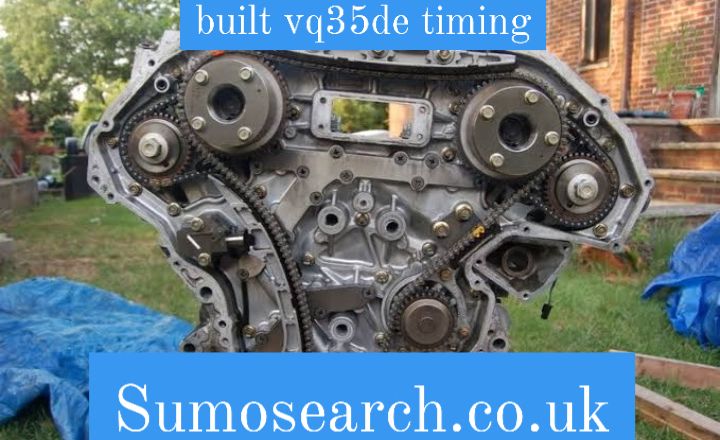Introduction
The built vq35de timing known for its reliability and high-performance capabilities, is a popular engine choice among car enthusiasts and tuners. One of the critical aspects of optimizing this engine’s potential lies in understanding its timing system. This article explores the intricacies of the built VQ35DE timing, offering insights into how proper timing can elevate the engine’s performance, longevity, and overall reliability.
Understanding the VQ35DE Engine
The built vq35de timing is a 3.5L V6 that has garnered attention for its balance of power and efficiency. It’s used in various vehicles such as the Nissan 350Z, Infiniti G35, and other models. This engine is highly regarded in the automotive world for its smooth power delivery and the potential for aftermarket upgrades. However, for those seeking peak performance, modifying the timing system can significantly impact the engine’s output.
The Importance of Engine Timing
Engine timing refers to the synchronization of various engine components, such as the camshaft and crankshaft, which determines the exact moments when the intake and exhaust valves open and close. In the VQ35DE, this timing is crucial for ensuring the engine runs efficiently, delivering both power and fuel economy. When the timing is off, the engine can suffer from poor performance, decreased fuel efficiency, and potentially even damage.
Built VQ35DE Timing: What Does It Mean?
A built vq35de timing to an engine that has been heavily modified for better performance. This could include internal modifications such as upgraded pistons, rods, and crankshafts. When it comes to timing, these modifications often require adjustments to the timing system to ensure that the engine is firing optimally. A built VQ35DE timing setup often includes custom tuning of the camshaft timing, ensuring that the engine performs at its highest level without compromising reliability.
Factors That Affect VQ35DE Timing
Several factors influence the timing of the VQ35DE engine. These include the camshaft profile, the condition of the timing chain, the ECU tuning, and the type of fuel being used. Modifying the camshaft to increase lift or change duration can alter the timing requirements, making a more advanced tuning necessary. Additionally, components like the timing chain and sprockets need to be durable and properly aligned to prevent timing issues.
Timing Chain and Sprockets: Vital Components for Built VQ35DE Timing
For a built vq35de timing the timing chain and sprockets are integral parts that must be upgraded for reliability and performance. The timing chain ensures that the camshaft and crankshaft stay in sync, and any wear or slack in the chain can result in a loss of performance or engine failure. High-performance sprockets and chains are often used in modified VQ35DE engines to handle the increased power and stress that come with aftermarket modifications.
ECU Tuning and Built VQ35DE Timing
One of the most essential tools for adjusting the timing in a built VQ35DE engine is the ECU (Engine Control Unit) tuning. The ECU controls various aspects of the engine’s performance, including the ignition and fuel timing. When you modify components such as the camshaft or increase the compression ratio, the ECU must be reprogrammed to account for these changes. Proper ECU tuning ensures that the engine delivers maximum power while keeping everything running smoothly.
Optimal Timing for Maximum Performance
When it comes to a built VQ35DE engine, achieving the optimal timing is a balancing act. Too much advance in the timing can result in knocking, while too much retardation can reduce power output. The ideal timing setup depends on various factors, including the type of fuel, the engine’s compression ratio, and the modifications made. Tuners often rely on a combination of dyno testing and real-world driving feedback to dial in the timing for optimal performance.
Timing Adjustments for Different Fuel Types
Fuel quality plays a significant role in engine timing. High-octane fuels allow for more aggressive timing, which can enhance power output in a built vq35de timing .
Common Timing Issues in Built VQ35DE Engines
Even with all the modifications and careful tuning, built VQ35DE engines can still face timing issues. . If the timing chain stretches or wears prematurely, it can throw off the synchronization between the camshaft and crankshaft, causing the engine to run poorly. Another issue that may arise is incorrect ECU tuning, which can result in erratic timing and reduced performance.
Conclusion: Getting the Best Built VQ35DE Timing
In conclusion, optimizing the built vq35de timing is crucial for unlocking the full potential of the engine. Whether you’re upgrading components for performance or simply maintaining your engine, understanding timing adjustments is key to achieving reliability, power, and longevity. Investing in quality parts, including high-performance timing chains, sprockets, and ECU tuning, ensures that your VQ35DE engine operates at its best. By considering factors such as fuel quality and the nature of your modifications, you can achieve the perfect timing setup that maximizes performance without sacrificing reliability.
By taking a careful, well-researched approach to tuning the timing system, enthusiasts can ensure that their built VQ35DE engines continue to deliver optimal performance on the road or track. For those looking to push the limits of their engine, advanced timing adjustments can be the difference between an average ride and a powerhouse of performance.
FAQs
1. How much does it cost to build a VQ35DE engine?
Building a VQ35DE engine can vary significantly in cost depending on the extent of the modifications. For a basic built engine, expect costs to range from $3,000 to $6,000. However, for more advanced builds with high-performance components, the cost can exceed $10,000.
2. What are the signs of incorrect timing in a VQ35DE engine?
Signs of incorrect timing include engine knocking, poor acceleration, reduced fuel efficiency, and engine misfires. If these symptoms occur, it’s crucial to check the timing system and make necessary adjustments.
3. Can a built VQ35DE engine be used for daily driving?
However, highly modified engines may require more maintenance and care compared to stock engines.
Also Read This: Cindy Jeanfreau at Dacula Elementary School: A Pillar of Education
